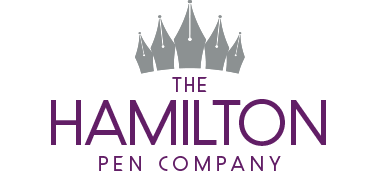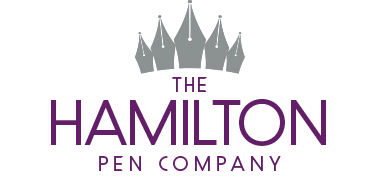Main Image Reproduced with thanks to Esterbrook
An American Icon!
As we welcome the Esterbrook brand to The Hamilton Pen Company, we would be remiss not to delve into its interesting history. Unlike some other ‘everyday products’, Pen companies often have detailed and intriguing histories embedded in culture and the hearts of the enthusiasts who are loyal and dedicated to the brand - Esterbrook is no exception. Known as a key piece of Americana, deeply connected to American cultural and political history, Esterbrook Pens are iconic - but you may be slightly confused by the title of this piece...lets dip into a little pen history!
Esterbrook, From Tin Mines to Steel Pens: The Early Years
Esterbrook Pen Company was established in 1858 by Quaker and entrepreneur, Richard Esterbrook. Originally, Esterbrook had studied business and opened a Stationers in Cornwall where he had grown up although his fortune came in the form of his success in Tin mining. Esterbrook used the profits from his Stationers to invest in the mining industry and quickly became very wealthy, so much so he took early retirement.

Portrait of Richard Esterbrook, pen maker and founder of R. Esterbrook & Co., the largest manufacturer of pens in the USA. Unknown Author, Public Domain via Wikimedia Commons
His son saw potential in the Stationery business and began to develop pens and after some initially unsuccessful attempts in the UK, Esterbrook’s son relocated to Philadelphia in 1856. Esterbrook’s son experienced financial difficulties with the early establishment of their pen manufacturing and asked Richard for support. Rather than providing purely financial support, Richard Esterbrook came out of retirement and utilised his business connections to recruit expert pen makers from Birmingham who would join Richard and his son in the US, setting up ‘The Steel Pen Manufacturing Company’ in Camden, New Jersey in 1858. Interestingly, the craftsmen selected by Esterbrook to help launch the manufacture of Steel nibs in the United States (which had until this point been non-existent) were employees and colleagues of John Mitchell who was a key player in the Birmingham Pen Industry and would later be closely involved in Esterbrook pens. With just 15 employees, the manufacture of steel pens began by hand using tools and equipment which was predominantly invented in-house. Because there was little in the way of steel pen manufacturing taking place in the US at the time, the expertise of the Birmingham specialists alongside the acumen of Esterbrook, was significant in the early growth of the company.

The Esterbrook Pens Co. plant stood at Cooper Street and Delaware Avenue, Camden, New Jersey. Image c.1920 Author Unknown. Public Domain: Source
However, in 1860 he dissolved the partnership with the Birmingham experts (reports of the craftsmen vary between 3 & 5 individuals) and changed the company name to ‘The Esterbrook Steel Pen Mfg. Co’. Esterbrook was incredibly savvy to the needs of the market, ensuring a variety of designs and styles to suit the growing population. Esterbrook pens were known for being high quality products which were long lasting, durable and versatile. Growth was steady for the company and additional buildings for manufacturing were added throughout the years alongside increasingly mechanised processes which allowed for demand to be met. As the 1900’s approached, Esterbrook was in competition with Perry & Co. as to who was the largest manufacturer of pen nibs in the world. Although such claims are generally disputed with multiple companies making claims to be ‘bigger and better’ than the rest, what is indisputable is that, at its height, Esterbrook was the largest pen manufacturer in the United States with production figures reaching 216 million units per year or 600,000 a day. In 1895, Richard Esterbrook passed away, leaving his empire to grow with his name and legacy at the helm.

Nº 356, 357 & 358 dip pen models by Richard Esterbrook. Credit: Fernando Martello 2007
Esterbrook Pens: Expansion (back) to the UK
Just a year after Richard’s death, Esterbrook saw the expansion possibilities in the UK market and so sought to establish themselves among the ranks of pen manufacturers in Birmingham. They appointed Hazell, Watson and Viney Ltd. as their UK agents and began to further develop the product range of Esterbrook pens. By 1912, the company had grown so much that a new 5 storey building was constructed in New Jersey to enable the continuation of production and to ensure that enough was manufactured to keep up with the demand from the UK. 1920 was an exciting year for Esterbrook as it was the year that they introduced their first fountain pen, with its own built-in ink supply! This fountain pen was in response to the growing popularity of fountain pens by those who had grown weary of the impracticalities of dip pens. Although initially produced for their US customers the UK market would soon receive its own Esterbrook fountain pen. Towards the end of the decade, 1928 to be precise, the UK Government introduced regulations which would include restrictions on the import of products from the United States. In response, Esterbrook undertook a licensing arrangement with John Mitchell’s in Birmingham to move production of Esterbrook Pens to the UK. Mitchell’s had transferred their operations to Moland Street Birmingham in 1912. The John Mitchell Pen Work Factory sat on the corner of Moland Street and Bagot street and the Mitchell name was well established. By the late 19th Century, Birmingham had established itself as a world centre for the manufacture of steel pens and nibs with more than half of the World's steel nibs made in Birmingham. Birmingham was also an epicentre for innovation with many new manufacturing techniques being trialed and perfected in the area, enabling factories in Birmingham to mass-produce pens efficiently and cheaply.

Advertisement card for R. Esterbrook & Co., promoting the 048 "falcon pen". Unknown Author, Public Domain via Wikimedia Commons
For UK operations, Hazell, Watson and Viney remained the selling agents and introduced the Esterbrook Fountain Pen to Britain by 1930. Although some fountain pens had been exported to the UK prior to this, fountain pens had been manufactured with gold and jewel tips so it wasn't until the 1930s that Esterbrook produced pens with a more practical and cost effective nib material. This material was Iridium and was utilised under the trade name of Duracrome by The Esterbrook Pen Company. The success of the resulting product ranges led to a further reorganisation of the company and Esterbrook Hazell Pens Ltd was conceived. The 1930s were a period of significance for Esterbrook as 1933 saw the introduction of the first interchangeable nib system which allowed for greater variation in writing style and flexibility within individual models which meant it was no longer a requirement to have multiple pens for multiple uses.

The venerable Esterbrook J from the mid to late 40's. Source: M Dreibelbis via wikimedia commons
The Second World War was damaging to the company, not just because of workers joining the war effort and the decline in sales figures which was felt by many, but also physically. On November 19th 1940, the Moland Street factory was hit by an incendiary bomb which destroyed half of the building, this was further exacerbated by the fact that during efforts to put out fires created by the bomb one member of the human water bucket chain accidentally used a bucket of paraffin which ultimately increased the fires power and destruction - all in all a pretty bad day!
Unlike many other businesses hit by bombs during the war, Esterbrook Hazell Pens was able to rebuild the factory during the war but were limited by government regulations once again. The UK Government supported the rebuild but stated that 50% of the building's capacity must be used for government related purposes. Appropriately, one of these ‘Government related purposes’ was The Stationery Office and the other (less appropriate to a pen manufacturing factory) was the Defence Department where ammunition from the Kynoch Works at Witton were quality assessed.
The Esterbrook Pen Company: Post-War
Two years after the end of World War Two, the UK branch of Esterbrook bought out John Mitchell and the American Esterbrook company acquired Hazell pens, bringing the organisation from both sides of the pond together to form The Esterbrook Pen Co. The post-war years saw a continued decline, particularly in export to countries who gained independence from the British Empire and who had the inclination for spending dollars in US markets rather than pounds in the UK. That being said, Esterbrook continued to develop products whose popularity began to reverse the downward trend in the business. As the company continued to innovate, Esterbrook took over Cushman & Denison in 1953 after they had launched the popular Flo-Master refillable marker two year earlier, in 1960 the UK Esterbrook Pens and Cushman and Denison were merged. The sixties was an interesting time for Esterbrook, with the release of the Valve Marker, Watercolour, Colourstick, Permanent Pen and Notewriter under the Gem brand name. The post-war period may have been something of a last hurrah for Esterbrook in some senses but those three decades solidified the Esterbrook name alongside some exceptional figures and cultural moments.
Esterbrook: A Cultural Icon
Esterbrook was very much integrated into the politics and culture of America in the 19th and 20th Centuries. Signing Ceremonies have been a tradition in American Politics dating back over a century. As part of these ceremonies, multiple pens are used to sign bills into law with key members of the community and those who were instrumental in the bill receiving one of the pens used for its signing as a commemoration of the event.

Packaging for the R. Esterbrook & Co. "Lincoln pen". Unknown Author, Public Domain via Wiki commons
Esterbrook pens have been a part of this tradition over many presidents including; Abraham Lincoln, John F. Kennedy and Lyndon B. Johnson. In 1964, the Civil Rights Act was signed by Lyndon B Johnson using 72 clear Lucite Esterbrook Fountain Pens, these were then gifted to attending dignitaries and supporters of the bill including; Robert F Kennedy (Attorney General at the time), Everett McKinley Dirksen, Hubert Humphrey, Rosa Parks and Martin Luther King Jr.

President Lyndon B. Johnson meets with Civil Rights leaders Martin Luther King, Jr., Whitney Young, James Farmer. Credit: Lyndon Baines Johnson Library and Museum. Image Serial Number: W425-2
It wasn’t just politics that embraced Esterbrook pens. Carl Barks, the famous Disney artist, brought Donald Duck to life with an Esterbrook No. 356 - ‘Awww Phooey’ NO REALLY! Charles M Shulz, creator of ‘Peanuts’ used the No. 914 for all his comics, Esterbrook brought us Snoopy and Woodstock! He loved the Radio nib so much that he bought up all the remaining stock when Esterbrook went out of business in the 1970s (spoiler alert!).

Charles Shulz. Credit: Roger Higgins, World Telegram staff photographer, Public domain, via Wikimedia Commons
Beyond the delights of the creative arts, Esterbrook pens could be found in the hands of millions of students learning to write. Esterbrook Pens have been a part of some of the biggest moments in human history…
The Esterbrook Pen Company and the Space Race
After Sputnik was launched in 1957, the race was on to get a man on the moon. Not wanting to be outdone by their rivals, the United States’ Federal Government and President Kennedy took action. In 1961 John F Kennedy delivered a message to congress, asking for 7-9 billion dollars for the expansion of the US space programme with the goal to have a man on the moon before the decade was over. Just 2 months after his rousing speech, Kennedy was able to arm himself with an Esterbrook pen and sign the bill which increased the NASA budget allowing for that goal of landing on the moon to be fulfilled.

President John F. Kennedy in his historic message to a joint session of the Congress, on May 25, 1961. Credit: NASA, Public domain, via Wikimedia Commons
July 20th 1969 saw the realisation of that dream when Apollo 11 - Neil Armstrong, Michael Collins and Edwin ‘Buzz’ Aldrin Jr. touched down in a Soutwestern portion of the Sea of Tranquility. This was one incredible achievement for all of mankind and Esterbrook played a small role in that moment.
After the Rise Comes the Fall: Esterbrook's Decline
Although the 1960’s was an exciting time culturally and was filled with significant historical moments, for Esterbrook it signified the beginning of their decline. The beginning of the decade saw export trade to the UK reduced and in 1967 the entire Esterbrook company was bought out worldwide by the Venus Pencil Company. This buy-out once again led to a name change, this time to Venus Esterbrook.
Under the name Venus-Esterbrook, the renew points for fountain pens continued to be produced. Numerous administrative changes were made but Venus-Esterbrook was short-lived as it was taken over by Berol in 1971. Although some products were being produced, under the Berol name Esterbrook began to fade into the history books. Faber-Castell acquired Venus-Esterbrook just two years later. The Birmingham factory was vacated in 1972 and from this point Esterbrook operations ceased. Esterbrook was no more.
Esterbrook: The Revival
The Esterbrook name lay dormant for several decades until, in 2014, Harpen Brand Holdings LLC Acquired the rights to the Esterbrook brand. They registered the brand name as Esterbrook est. 1858 with the addition of the phrase ‘ America’s Original Pen Company’. Under the brand they released a series of Esterbrook fountain pens and ballpoint pens which included reworkings of classic models such as the ‘Deluxe’ and the ‘J’ ballpoint which were originally released in the 1950s.
A short 4 years later, Kenro Industries acquired the Esterbrook brand and has been pivotal in the revival of the brand. The timing of the takeover was ideal as Americana and the revival of nostalgic American brands had begun to take hold of the general population.
Kenro honoured Esterbrook’s New Jersey origins where possible but had to relocate to Mineola New York which is just 120 miles north of the original headquarters. Esterbrook had risen to fame through the Great Depression and had held on throughout the Post-War period and so alongside the brand name retains a sense of pride and an enduring spirit which Kenro encapsulates through its reimagining of the Esterbrook pens. The ‘Estie’ is an homage to the original spirit of Esterbrook and the tenacity of the Cornish Quaker whose Tin Mining Fortune and entrepreneurial spirit took British pen making excellence to the US and created one of the most iconic American brands.
The revived Esterbrook satisfies the increasing demand of collectors and enthusiasts for the original pens as well as breathing new life into the writing instruments which has enticed a new generation of Esterbrook fans. The authentically old-fashioned style is retained in the new models alongside the demand of quality products which the name requires.
Kenro released a Manifesto for their vision of a revived Esterbrook brand, which states:
‘We want to reconnect with consumers, rebuild interest in fine writing and penmanship, revolt against the decline of handwriting in American schools, reestablish brand image as an American Original, regain trust and market share with retail partners, and revive the values and spirit of Richard Esterbrook for the 21st century’

Esterbrook Estie Limited Edition Fountain Pen - Evergreen with Palladium Trim
Feedback and reviews of the new releases over the past two years would suggest that Kenro is achieving what it set out to do and Esterbrook is the (old) new kid on the block for American quality writing instruments.
Esterbrook at The Hamilton Pen Company
The Hamilton Pen Company is thrilled to be able to bring Esterbrook to our collections. The ‘Estie’ is a tribute to the brand and its history. Providing a sense of 1930’s nostalgia, the ‘Estie’ reminds us of a time where a fountain was an integral part of life and a good fountain pen was the ultimate accessory.
Explore our selection of products step back in time with Esterbrook.
POSTSCRIPT
After publishing this piece, we were contacted by Helen Alsop who shared with us a wonderful piece of Esterbrook history which was shared with her husband.
Her husband is a classical musician who, ahead of playing the 'Last Night at the Proms' was given this incredible document by a neighbour.

This is a pristine testing sheet which features handwritten notation and the signature of Sir Henry Wood, infamous conductor and founder of the Proms. Although we cannot fully verify the pen being tested, it seems incredibly likely that Sir Henry was testing out an Esterbook!
Mrs Alsop had this to say: "Was he actually trying out an Esterbrook??? Which model?? We’ll never know. Henry Wood was a household name in the 1930’s and looking at this I have often imagined him being ‘spotted’ by an excited fan as he was out doing a bit of shopping"
We were thrilled to receive Mrs Alsop's email and thank her for sharing this wonderful example of Music and Pen history colliding!



